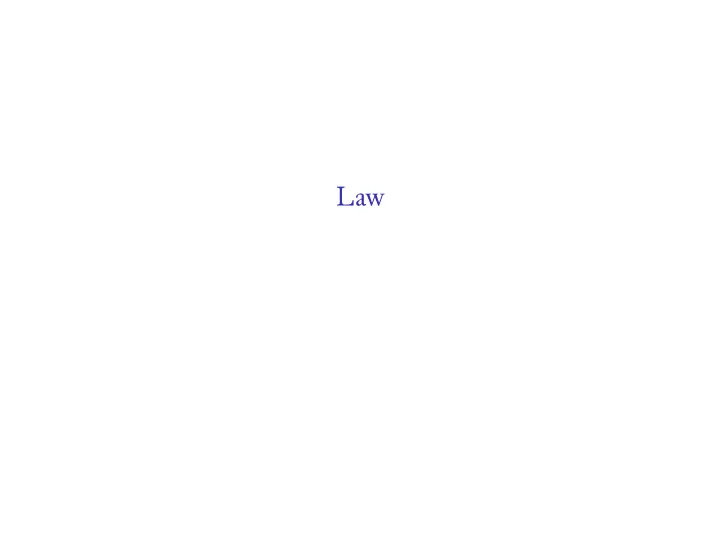

Law
Civil Law: Fines Objectives: 1. Compensation 2. Retribution (punitive damages) 3. Deterrence (exemplary damages) Chief Instruments of Punishment Today Criminal Law: Incarceration Objectives: 1. Incapacitation 2. Deterrence 3. Rehabilitation 4. Retribution
Chief Instruments of Punishment Today Criminal Law: Incarceration Civil Law: Fines Objectives: Objectives: 1. Incapacitation 1. Compensation 2. Deterrence 2. Retribution (punitive damages) 3. Rehabilitation 3. Deterrence 4. Retribution (exemplary damages)
Branches of Government Today Legislative Executive Judicial Enforces law Interprets law Drafus law (Head of state; (Parliament) (Judges) ministers)
Branches of Government in Medieval Iceland Legislative Executive Judicial Courts Courts
Christian Law 1. Fines Objectives: 1.1 Deterrence 1.2 Retribution 1.3 Compensation 2. Outlawry Objectives: 2.1 Deterrence 2.2 Retribution In the 1270s, Christian law became as much about the King as about religion. Chief Instruments of Punishment in Medieval Iceland Criminal/Civil Law 1. Fines Objectives: 1.1 Compensation 2. Outlawry Objectives: 2.1 Deterrence 2.2 Retribution 2.3 Incapacitation
Chief Instruments of Punishment in Medieval Iceland Criminal/Civil Law Christian Law 1. Fines 1. Fines Objectives: Objectives: 1.1 Compensation 1.1 Deterrence 1.2 Retribution 2. Outlawry 1.3 Compensation Objectives: 2. Outlawry 2.1 Deterrence Objectives: 2.2 Retribution 2.3 Incapacitation 2.1 Deterrence 2.2 Retribution In the 1270s, Christian law became as much about the King as about religion.
The Nature of Punishment in Medieval Iceland ▶ Reflects rural nature of early Germanic dispute settlement ▶ Based in kinship ▶ Compensation or retribution ▶ Plaintiff in charge of enforcement → saga material
The Judicial Organization of Medieval Iceland Legal Council of the Alþingi / National Assembly Fifuh Court Qvarter Court N Qvarter Court E Qvarter Court S Qvarter Court W 12 goðar 9/12 goðar 9/12 goðar 9/12 goðar ▶ Legislative and judicial branch in one; no executive branch ▶ Each fsee man could choose what regional goði to support ▶ All fsee men were expected to attend the National Assembly ▶ Numbers of chiefuains vary by source and period ▶ 9/12: the additional seats existed in the Alþingi’s Law Council only
Outlawry The condition of being systematically denied legal protection. ▶ Full outlawry ( skóggangr ) , i.e. for life. The toughest ruling in medieval Icelandic law. ▶ Lesser outlawry ( fko ̨ rbaugsgarðr ) , for three years. Both forms of outlawry entailed the forfeiture of all property.
Oral Law ▶ The lawspeaker ( lǫgsǫgumaðr ) was charged with reciting / reading out the land’s laws at the annual Alþingi , one third per session ▶ Laws reportedly first written down in 1117–1118; the office of lǫgsǫgumaðr would have gradually lost some of its urgency thereafuer
Bibliography Dennis, Andrew, Peter Foote, and Richard Perkins, trans. Laws of Early Iceland . 2 vols. Winnipeg: University of Manitoba Press, 1980–2000. Miller, William Ian. Bloodtakjng and Peacemakjng: Feud, Law, and Society in Saga Iceland . Chicago: University of Chicago Press, 1990. Sandvik, Gudmund, and Jón Viðar Sigurðsson. “Laws.” In A Companion to Old Norse–Icelandic Literature and Culture , edited by Rory McTurk, 223–244. Malden, MA: Blackwell, 2007.
Recommend
More recommend